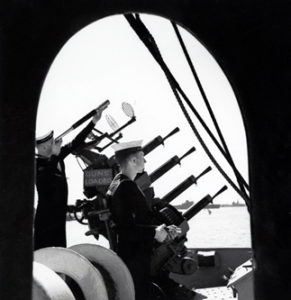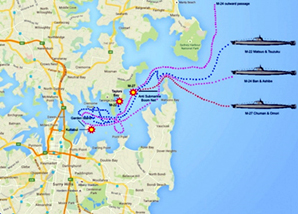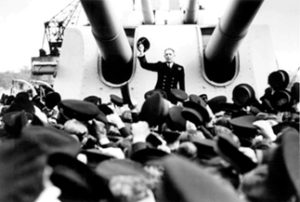By Richard H Pelvin and Jozef H Straczek
This paper was provided courtesy of the Sea Power Centre – Australia. It was first published in 2003 and is available on the Sea Power Centre website Feature Histories page. Both authors worked for the Defence Department in a range of roles over many years. Jozef Straczek was the Senior Naval Historical Officer in the Naval History Directorate, Department of Defence, Canberra. He has written or contributed to many books and articles on naval history. Among his works is the reference book, The Royal Australian Navy: ships, aircraft and shore establishments (Sydney: Navy Public Affairs, 1996). Richard Pelvin worked for ten years in the historical sections of the Army and Navy. He was also Curator of Official Records at the Australian War Memorial and has written and published widely on military, naval and aviation history.
In the morning of 8 December 1941 Japanese troops commenced landing in Northern Malaya. This assault was co-ordinated with the Japanese strike against the United States Pacific Fleet at Pearl Harbor (7 December, local time). As a consequence of these actions the Royal Australian Navy found itself facing a new enemy and fighting a new war. A war that was to last four years and see Australian ships and personnel operate across the vast expanse of the Pacific and Indian Oceans.
Prior to the outbreak of hostilities six corvettes of the RAN had already been based at Singapore. Other vessels, including the cruiser HMAS Hobart, the destroyer HMAS Vampire and the sloop HMAS Yarra, were ordered back to Australian waters to help meet this new threat. Vampire formed part of the escort of HM Ships Prince of Wales and Repulse on their ill-fated sortie to attack Japanese landing forces at Kuantan on Malaysia’s east coast. She rescued 225 survivors after both the capital ships had been sunk by Japanese naval aircraft.

After this disaster the Australian ships were heavily involved in escorting the troopships bringing reinforcements to Singapore, often in the face of severe Japanese air attacks. On one occasion Yarra lifted over 1300 survivors from the troopship Empress of Asia after it had been dive bombed and sunk. A few days prior to this, on 27 January, Vampirecarried out a spirited but unsuccessful attack on a superior Japanese landing force at Endau. An accompanying British destroyer, HMS Thanet, was sunk. Other ships carried out patrol and evacuation duties. After taking part in the evacuation of Singapore the Australian ships formed part of the force allocated for the naval defence of the Netherlands East Indies.
To remove a threat from their flank while attacking eastern Java the Japanese Navy launched a heavy air raid on Darwin, which was being used by the Allies as a staging point for reinforcements. The bombers hit the town, airfield and harbour facilities, sinking five merchant ships and the destroyer USS Peary. Many other vessels, including the hospital ship Manunda, were damaged. This was the first of many such raids.
In Javanese waters, on 27 February a combined Australian, British, American and Dutch striking force composed of five cruisers, including HMAS Perth, as well as a number of destroyers, engaged Japanese forces covering the approach of a landing force. In this action, the Battle of the Java Sea, the Allies lost two Dutch cruisers and three destroyers with damage to a British cruiser. Subsequently the Allied naval forces were ordered to withdraw from the Dutch East Indies. However, whilst attempting to reach Australia through Sunda Straits, Perth, accompanied by the cruiser USS Houston, RAN into a Japanese force landing troops in Bantam Bay. In the ensuing action both cruisers were sunk with heavy loss of life. Many of the survivors were to subsequently die as prisoners of war.

HMAS Perth displayed incredible fight while outnumbered by a superior force. The ship, superbly led by Captain Hector ‘Hec’ Waller was eventually sunk in the early hours of 1 March 1942.
The Australian built corvettes were able to withdraw successfully to Australia while the destroyer Vampire had reached Ceylon. Also fortunate was the destroyer HMAS Vendetta which had been immobilised and under repair in dry dock at Singapore at the time of the attack. She eventually reached Australia after an epic towing operation through enemy controlled waters. Less fortunate, the sloop Yarra which, whilst escorting a convoy south of Java, was surprised by a Japanese heavy cruiser squadron. Despite putting up a gallant fight she was overwhelmed and sunk on 4 March. The following month, on 9 April, Vampire was also sunk by Japanese carrier aircraft off Ceylon.
With the occupation of Malaya and the Dutch East Indies the strategic centre of gravity moved east. The Japanese, having occupied Rabaul and points on the northern New Guinea coast decided to occupy the Solomon Islands and Port Moresby. This would enable them to deny the Allies bases from which to attack Rabaul and also to threaten the RANs Pacific lines of communication. The Combined Operations Intelligence Centre, located in Melbourne, linking information from locally based signals intelligence units, Coastwatchers and aerial reconnaissance, issued an assessment on 25 April that a Japanese assault on Port Moresby was imminent.
On 1 May the cruisers HMA Ships Australia and Hobart and USS Chicago escorted by three American destroyers sailed from Hervey Bay to rendezvous with an American force built around the aircraft carriers Yorktown and Lexington. The Australian force, designated Task Force 44, reinforced with a fourth US destroyer and detached on 7 May to block the movement of any Japanese ships through the Jomard Passage. The force was bombed that day by Japanese aircraft incurring only superficial damage. Although no other enemy were sighted the presence of the Allied ships was influential in the Japanese decision to withdraw the Moresby Invasion force. Meanwhile US carrier aircraft had sunk the Japanese light carrier Shoho the same day.
In the action between the American and Japanese fleet carriers, Shokaku and Zuikaku on the 8th, the Lexington was sunk and the Yorktown badly damaged. Neither of the Japanese carriers were sunk though the Shokaku was badly damaged. Although the Japanese had inflicted greater losses in ships on the Allies they had not achieved their strategic objectives. Further, the Shokaku and Zuikaku had suffered such heavy losses in aircraft and personnel that they were not available for the Midway Operation in early June.
The combined effects of the battle of the Coral Sea, Midway and later the Solomons Campaign turned the tide of the Pacific War. Although no Australian vessels were present at the Battle of Midway, Australian naval signals intelligence played an important part in helping to monitor Japanese movements and intentions and passing this information onto the Americans at Pearl Harbor.
Just prior to the Midway Operation the Japanese again brought the war to Australia’ shores with an attack on Sydney Harbour by midget submarines. The accommodation ship HMAS Kuttabul was sunk alongside Garden Island but all three Japanese submarines were lost. This was not the first incursion by Japanese submarines into Australian waters. In January four minelaying boats had operated in northern Australian waters, laying mines off Darwin and in Torres Strait. One, the I-124, had been sunk by the corvette HMAS Deloraine, assisted by other RAN and US vessels. In February and March the submarine I-25 had launched its reconnaissance seaplane on flights over Sydney, Melbourne and Hobart before moving on to New Zealand and Fiji. Simultaneously, submarine operations off the west coast resulted in the sinking of two merchant vessels and attacks on three others.

The midget attack presaged a submarine campaign against shipping on Australia’s eastern coast which lasted from early June until August. Fourteen ships were attacked of which six were sunk. Convoys were introduced on the Australian east coast on 6 June. The Japanese submarines also shelled Sydney and Newcastle with little resultant damage. Further operations carried out in the first half of 1943 resulted in the loss of another eleven ships including the hospital ship Centaur.
While the first submarine campaign was being waged, plans were in hand to eject the Japanese from the Solomon Islands. On 7 August an Allied force landed on Guadalcanal. Naval support was provided by an Australian/American force of cruisers and destroyers, including HMAS Australia, Canberra and Hobart. Shortly after midnight on 9 August a Japanese cruiser squadron attacked the allied force sinking Canberra and three American cruisers. Although operations in the Solomons were to continue, further RAN involvement was limited, although valuable support was provided by Coastwatchers.
Later in August the Japanese landed at Milne Bay. Units of the RAN had convoyed troopships to the area and latter supported the defence of the area from the sea. On 29 August the new destroyer HMAS Arunta sank the Japanese submarine RO33 off Port Moresby, thereby removing a major threat to the logistic support for Australian troops. With the successful conclusion of the Milne Bay battle the RAN provided naval support for forces operating in northern New Guinea and commenced development of the string of bases that would be opened up along that coast to support the Allied advance. Operations included conducting hydrographic surveys, shore bombardments, t RAN sporting troops and providing logistic support.
December 1942 saw the commencement of Operation Lilliput, which over a six-month period saw the transportation of 60,000 tons of supplies and 3,802 troops from Milne Bay to Oro Bay, escorted by Australian corvettes. In March 1943 the Japanese suffered a major defeat when a reinforcement convoy heading for Lae was destroyed by Allied air attack in the Battle of the Bismarck Sea. Intelligence on this convoy was provided by the joint RAN /USN codebreaking organisation in Melbourne.
This same period saw a lesser but significant level of RAN activity in the area north and west of Darwin. While supporting commando operations in Timor the destroyer HMAS Voyager was lost in September 1942 as was the corvette HMAS Armidale in December. With the withdrawal of the commandos the RAN continued to support covert operations in the area by the Services Reconnaissance Department (SRD) which were maintained until the end of the War. In September 1943 SRD operatives in small boats carried out Operation Jaywick, successfully attacking Japanese shipping in Singapore Harbour. They had been t RAN sported there in a small captured fishing vessel, the Krait. In late 1944 another covert attack on Singapore Harbour was mounted by the SRD but was to end in disaster. Throughout the war the RAN units based on Darwin were also to provide support for settlements, missions, airfields and other military installations in the area. On 22 January 1943, while undertaking one of these voyages, the stores carrier HMAS Patricia Cam was bombed and sunk.
As 1943 and 1944 progressed Australian ships were involved in the campaigns to oust the Japanese from West New Guinea and adjacent islands. In the succession of landings carried out the cruisers and destroyers carried out bombardments and provided seaward cover. The corvettes escorted merchant ships through the area. The armed merchant cruisers HMAS Manoora, Kanimbla and Westralia were converted to Landing ships Infantry (LSI). As such they were to take part in many of the amphibious operations such as those at Hollandia, Biak, Aitape and Morotai which brought the Allies closer to the Philippines.
In July 1943 the cruisers were detached from the 7th Fleet for operations in the Solomons area. Enroute to Espiritu Santo in the New Hebrides Hobart was torpedoed by a Japanese submarine and put out of action for nearly two years. In the previous month the heavy cruiser Shropshire had been transferred from the Royal Navy as a replacement for Canberra.

Captain John A Collins CB RAN assumed command of HMAS Shropshire on 7 April 1943 and she commissioned as HMAS Shropshire at Chatham on 20 April 1943.
Morotai was taken in September 1944 and from there the landings in Leyte were mounted. The LSIs landed American troops at Panaon while the covering forces included Australia, Shropshire, Arunta and her sister ship HMAS Warramunga. Survey work was carried out by the frigate HMAS Gascoyne. On 20 October a Japanese aircraft crashed into Australia causing heavy damage and casualties and forcing her withdrawal with Warramunga as escort.
In the Battle of Surigao Strait on 25 October Shropshire and Arunta formed part of the large American force formed around six battleships which overwhelmed a much smaller Japanese battle squadron attempting to attack the amphibious forces. Shropshire engaged the battleship Yamashiro with gunfire while Arunta carried out a torpedo attack. Surigao Strait was the last action fought using the traditional battle line. The Battle of Leyte Gulf, of which it was part, remains the largest naval battle in history and saw the end of the Imperial Japanese Navy as a fighting force.
In January 1945 the Allies commenced the invasion of Lingayen. Australia, now repaired, Shropshire, Arunta and Warramunga carried out bombardment duties while Manoora, Kanimbla and Westralia landed troops. The sloop HMAS Warrego and the frigate HMAS Gascoyne performed escort duties and carried out survey tasks in Lingayen Gulf. The Allied ships came under frequent air attack, especially from kamikaze aircraft. Gascoyne and Westralia were near missed and Arunta damaged. Australia, however, was grievously damaged when, between 5 and 9 January, she was hit five times. She continued to carry out her bombardment duties until ordered to retire with Arunta on 9 January. The other vessels continued operations in the area until March, by which time the repaired cruiser Hobart had rejoined.
At this time the British Pacific Fleet commenced operations in the Pacific. The RAN was initially represented by the destroyers HMA Ships Quickmatch and Quiberon as well as a number of corvettes. Later the destroyers HMA Ships Napier, Norman, Nizam and Nepal joined. All of these vessels had previously served in the Indian Ocean with the British Eastern Fleet. The destroyers had taken part in attacks on Japanese oil installations in Sumatra and the N Class vessels had supported the Army in Burma. The corvette HMAS Launceston had sunk the submarine RO 110 off Vizagapatam. The destroyers saw service in support of the Okinawa operations in April while the corvettes formed two minesweeping flotillas.
The RAN ‘s last operations in the Pacific were those in support of Australian troops in the landings at Tarakan, Brunei and Balikpapan in May, June and July respectively. As before the cruisers and destroyers provided gunfire support, troops were landed from the three LSIs and the sloops, frigates and corvettes carried out patrol, escort and surveying duties. RAN vessels, especially the smaller motor launches, were also active in the final operations in New Guinea waters.
Upon the conclusion of the war the RAN played a significant part in the arrangements for the surrender of various Japanese forces in South East Asia and the South West Pacific. Minesweeping continued for a number of years after the surrender and Australian service personnel and prisoners of war from around the region were repatriated.
The Pacific War saw an expansion of the infrastructure necessary to support wide ranging naval operations. Defensive minefields were laid in Australian, New Zealand and New Guinea waters. Harbour defence systems were established around Australia and forward operating bases provided logistic support to ships close to the combat areas. The manufacture of mines, torpedoes, guns and ammunition was undertaken as was the development and construction of sophisticated electrical equipment.
Shipbuilding, repair and maintenance facilities were greatly expanded, including the construction of the Captain Cook Graving Dock at Garden Island. Three destroyers, twelve frigates and sixty corvettes as well as numerous smaller vessels were built. A large number of merchant ships were converted for naval purposes and many others were defensively armed and given mine countermeasures. Most of this work was carried out by the men and women of the unarmed forces who worked in the factories and dockyard around Australia.
Women were enlisted into the Navy for the first time and helped provide many of the support functions so desperately needed by a navy at war. Some of these women played an invaluable, and largely unrecognised, role in supporting the large intelligence organisation that had been established. One, Ruby Boye, also served as a Coastwatcher at Vanikoro from February 1942 to October 1944. Before the end of the war the peak strength of the RAN had reached 39,650 with approximately 337 vessels ranging from cruisers to motor launches in service.
In proportion to its size the RAN made a significant contribution to the Allied effort in the war against Japan. This was more noticeable in the earlier days of the war when operations were taking place in Australia’s proximity and before the United States was able to fully deploy its manpower and industrial strength. The amphibious operations, survey, minesweeping, convoy and patrol tasks from late 1942 to 1945 tend to be overlooked yet they were all essential components in the exercise of sea power and ultimately the war in the Pacific was a maritime campaign.




